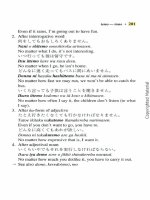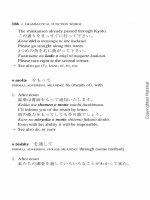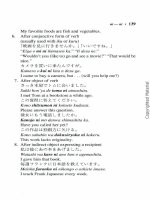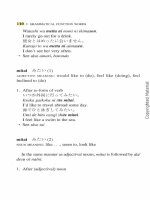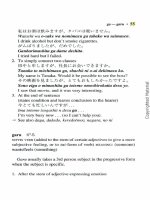Handbook of Japanese Mythology phần 1 pps
Bạn đang xem bản rút gọn của tài liệu. Xem và tải ngay bản đầy đủ của tài liệu tại đây (4.67 MB, 40 trang )
Cover-image not available
Handbook of
Japanese Mythology
TITLES IN ABC-CLIO’s
Handbooks of World Mythology
Handbook of Arab Mythology, Hasan El-Shamy
Handbook of Celtic Mythology, Joseph Falaky Nagy
Handbook of Classical Mythology, William F. Hansen
Handbook of Egyptian Mythology, Geraldine Pinch
Handbook of Hindu Mythology, George M. Williams
Handbook of Inca Mythology, Catherine Allen
Handbook of Native American Mythology, Dawn Bastian and Judy Mitchell
Handbook of Norse Mythology, John Lindow
Handbook of Polynesian Mythology, Robert D. Craig
HANDBOOKS OF WORLD MYTHOLOGY
Handbook of
Japanese Mythology
Michael Ashkenazi
Santa Barbara, California • Denver, Colorado • Oxford, England
Copyright © 2003 by Michael Ashkenazi
All rights reserved. No part of this publication may be reproduced, stored in a
retrieval system, or transmitted, in any form or by any means, electronic, mechanical,
photocopying, recording, or otherwise, except for the inclusion of brief quotations in a
review, without prior permission in writing from the publishers.
Library of Congress Cataloging-in-Publication Data
Ashkenazi, Michael.
Handbook of Japanese mythology / Michael Ashkenazi.
p. cm. — (Handbooks of world mythology)
Includes bibliographical references and index.
1. Mythology, Japanese—Juvenile literature. I. Title. II. Series.
BL2203.A86 2003
299'56—dc21
2003008649
ISBN 1-57607-467-6; 1-57607-468-4 (e-Book)
07 06 05 04 03 10 9 8 7 6 5 4 3 2 1
This book is also available on the World Wide Web as an e-book.
Visit for details.
ABC-CLIO, Inc.
130 Cremona Drive, P.O. Box 1911
Santa Barbara, California 93116-1911
This book is printed on acid-free paper
I
.
Manufactured in the United States of America
To Zaf,
for, among many things,
first getting me interested in Japan
Preface, xv
1 Introduction, 1
Transliteration of Japanese Terms, 2
Mythology and the Japanese World, 3
Great Tradition and Little Traditions, 4
Little Traditions and Great Tradition in the Japanese Context, 5
External Sources of Japanese Traditions, 5
The Myth of Japan, 7
Japanese Topography and Geography, 8
Population, 10
Japanese History and Traditions, 12
Archaic Period: Jo¯mon, Yayoi, and Kofun (Approximately
1000 B.C.E. to 650 C.E.), 12
The Roots of Empire (Approximately 500–781 C.E.), 14
The Aristocratic Period (Approximately 650 C.E.–1185), 16
The Medieval Period (1185–1600), 19
The Premodern and Modern Periods (1615–), 21
Social History, 22
The Powerful, 23
The Powerless, 24
Outsiders and Rovers, 24
Japanese Family Relations, 25
The Mythic Traditions, 26
Shinto¯, 27
Buddhism, 36
Demons, Goblins, Witches, Ghosts, Hermits, and Wizards, 55
Humans, 56
Non-humans, 56
vii
Shugendo¯, 57
Outlying Myth Complexes, 58
Okinawa and the Ryukyu Islands, 59
Ainu, 61
Japanese Myth in the Modern World, 64
Sources of Japanese Mythology, 65
The Shinto¯Canon, 66
Buddhist Literature: The Sutras and Commentaries, 67
Ainu Yukari, 68
Ryukyuan Myths, 69
Language and Writing, 69
Interpreting Japanese Myth, 70
Universal Types, 71
Structuralist Interpretations, 71
Diffusion, 71
Interpretation on the Basis of Archaeo-Anthropology:
The Attempt to Extract Prehistory from Myth, 72
Japanese Uniqueness Myths, 73
2 Mythic Time and Space, 75
Creation and Consolidation: The Foundation Myths, 76
Susano-wo’s Crimes and the Sun Goddess, 77
The Creation of Food for Humankind, 79
Susano-Wo and the Eight-Tailed Dragon, 80
O
¯
kuninushi and His Eighty Brothers, 80
O
¯
kuninushi Is Tested by Susano-wo, 81
O
¯
kuninushi and Sukunabikona Finish Creating the Land, 82
The Heavenly Deities Subdue the Land: First Attempt,
with Weak Son, 83
The Heavenly Deities Subdue the Land: Second Attempt,
with Pheasant, 84
The Heavenly Deities Subdue the Land: Third Time Lucky, 85
The Heavenly Grandson Descends to Take Possession
of the Central Land of the Reed Plains, 86
Ho-ori Loses His Brother’s Fish-Hook, 87
Jimmu Tenno, the First Emperor, 88
Yamato-takeru, the Hero of Yamato, 90
The Empress Jingu¯ Subdues Korea, and the Kami Hachiman Is Born, 93
The Age of Heroes, 94
Tawara Toda, the Archer, 95
Contents
viii
Raiko¯ and His Band of Heroes, 96
Woman Heroes, 96
Benkei and Yoshitsune, 96
Buddhist Myths, 98
The Life of Shakyamuni and the Formation of Buddhism, 99
The Arrival of Buddhism in Japan, 99
Morality Tales, 100
Mythical Spaces, 100
Buddhist Spaces, 101
Shinto¯ Spaces, 102
3 Deities, Themes, and Concepts, 109
Ae-oina Kamui (Ainu), 109
Aizen-Myo¯-o¯, 110
Ajishikitakahikone-no-kami, 110
Ama-no-uzume, 111
Amaterasu-o¯-mikami, 112
Amenominakanushi-no-kami, 113
Ame-no-wakahiko, 114
Amida Nyo¯ rai, 115
Animals, 115
Apasam Kamui (Ainu), 120
Assembly of the Gods, 121
Atago-gongen, 122
Bakemono, 123
Battabara-bosatsu, 123
Benkei, 123
Benzaiten, 126
Bimbogami, 126
Binzuru-sonja, 126
Bishamon-ten, 128
Central Land of the Reed Plains, 128
Chikap Kamui (Ainu), 128
Chimata-no-kami, 128
Chiseikoro Kamui (Ainu), 129
Chu¯jo¯-hime, 129
Chu¯shingura, 130
Daigenshuri-bosatsu, 131
Daikoku, 132
Dainichi Nyo¯rai, 132
Contents
ix
Daitoku Myo¯-o¯ (-bosatsu), 133
Dakiniten, 133
Daruma, 134
Datsueba, 135
Divination, 135
Divine Descent, 137
Divine Rulership, 137
Do¯jo¯-ho¯shi, 138
Doso¯ jin, 139
Dπzoku-shin, 140
Earthly Kami (Kunitsu-kami), 141
Ebisu, 142
Emma-o¯, 144
En-no-Gyo¯ ja, 144
Fii Nu Kang (Ryukyuan), 145
Food Deities, 146
Fox, 148
Fu-daishi, 151
Fudo¯Myo¯-o¯, 151
Fugen-bosatsu, 153
Fujin, 154
Fukurokuju, 155
Futsunushi-no-kami, 155
Gama-sennin, 156
Gekka-o¯, 156
Ghosts, 156
Gongen, 158
Go-shintai, 158
Gozu-tenno, 159
Gut Length, 159
Hachidai Ryu¯-o¯, 159
Hachiman, 160
Hashinau-uk Kamui (Ainu), 161
Heavenly Floating Bridge, 161
Heroes, 161
Hidarugami, 164
Hiruko, 165
Hitokotonushi-no-kami, 166
Hoderi-no-mikoto, 166
Ho-ori-no-mikoto (Hikohohodemi), 167
Contentsx
Ho¯ tei, 168
Hotoke, 168
Ida-ten, 169
Imperial Regalia, 169
Inari, 170
Izanagi and Izanami, 172
Izumo, 177
Japanese Uniqueness, 179
Jewels, 180
Jimmu Tenno, 181
Jinushigami, 183
Jizo¯, 183
Jurojin, 185
Ju¯rokurakan, 185
Kagutsuchi-no-kami, 186
Kamado-gami, 186
Kami, 187
Kamikaze, 188
Kamimusubi, 190
Kamui Fuchi (Ainu), 191
Kandakoro Kamui (Ainu), 192
Kannon (Kanzeon-bosatsu), 193
Kappa, 195
Kasuga Daimyo¯jin, 196
Kawa-no-kami, 197
Kenash Unarabe (Ainu), 197
Kim-un Kamui (Ainu), 198
Kinashut Kamui (Ainu), 199
Kintoki (also Kintaro¯), 199
Kishimo¯ jin, 200
Ko¯bo¯ Daishi, 201
Kojaku Myo¯-o¯, 205
Kokka Shinto¯, 206
Koku¯zo¯-bosatsu, 207
Koma-inu, 207
Kongo¯, 209
Ko¯no¯ hanasakuya-hime, 210
Konpira-daigongen, 211
Kotankor Kamui (Ainu), 211
Kotoshironushi-no-kami, 212
Contents
xi
Koyasu-gami, 213
Kuraokami-no-kami, 213
Kuyebiko, 213
Marebito, 214
Marishi-ten, 215
Miroku-bosatsu, 215
Mirror, 216
Miyazu-hime, 216
Mizuhame-no-mikoto, 217
Monju-bosatsu, 217
Moshirikara Kamui (Ainu), 218
Mountains, 218
Myo¯gen-bosatsu, 220
Nai-no-kami, 220
Namazu, 220
Nihonjin-ron, 222
Ninigi-no-mikoto, 222
Ni-o¯, 223
Nusakoro Kamui (Ainu), 225
Okamutsumi-no-mikoto, 226
Okikurmi (Ainu), 226
O
¯
kuninushi, 228
Oni, 230
Orihime and Kengyu¯, 232
O
¯
toshi-no-kami, 233
Owatatsumi-no-kami, 233
Oyamatsumi-no-kami, 234
Oyashima-kuni, 234
Pauchi Kamui (Ainu), 234
Pure Land, 235
Raiden (also Raijin), 236
Raiko¯, 236
Renge, 238
Repun Kamui (Ainu), 238
Rokuji Myo¯-o¯, 239
Rusugami, 239
Ryu¯jin (also Ryu-o¯), 240
Ryu¯ju (Nagarjuna), 241
Sae-no-kami, 241
Sages (Buddhist and Daoist), 241
Contents
xii
Sanbo¯-Ko¯jin, 244
Sarutahiko-no-kami, 244
Seishi-bosatsu, 245
Sengen, 245
Shaka (Shakyamuni, sage of the Shakya clan), 246
Shi Tenno, 247
Shichi Fukujin, 247
Shiramba Kamui (Ainu), 249
Sho¯ki, 249
Sho¯-ten, 250
Sho¯toku Taishi, 250
Shozuka-no-baba, 251
Shumisen (Mt. Meru, Sumeru), 252
Snakes, 252
Stones, 254
Suijin (also Mizu-no-kami), 255
Suitengu, 256
Sukunabikona, 256
Sumiyoshi, 257
Susano-wo, 259
Swords, 261
Taira, 263
Takamagahara, 264
Takamimusubi-no-kami, 265
Takarabune, 266
Takemikazuchi-no-kami, 266
Takeminakata-no-kami, 267
Ta-no-kami, 268
Tawara Toda (Toda Hidesato, Fujiwara Hidesato), 268
Tengu, 270
Tenjin, 272
Tenson (Ryukyus: Okinawa), 273
Thunder Deities, 274
Toyoashihara-no-chiaki-no-nagaioaki-no-mizuho-no-kuni, 277
Tsukiyomi-no-mikoto, 277
Ugajin, 277
Uminai-gami and Umikii-gami (Ryukyus), 278
Underworld, 278
Urashimataro¯, 281
Ususuma Myo¯-o¯, 282
Contents
xiii
Waka-ush-kamui (Ainu), 283
Weapons, 284
Yakushi Nyo¯rai, 286
Yama-no-kami, 287
Yamato, 287
Yamato-takeru, 288
Yama-uba, 290
Yaoyorozu-no-kamigami, 291
Yoshitsune, 291
Yuki-onna, 293
Yushkep Kamui (Ainu), 294
Zao¯-gongen, 295
Table of Minor Deities, 295
4 Annotated Print and Nonprint Resources, 299
Books and Articles, 299
Videos, 303
Websites, 304
General Japan, 304
Buddhism, 305
Shinto¯, 305
Mythology in Art and History, 306
Myths and Glossaries, 307
Glossary, 311
Appendix: Primary Sources, 319
Index, 331
About the Author, 377
Contents
xiv
A
project of this magnitude contains numerous surprises. I had thought
that I was fairly well acquainted with Japanese mythology, having spent
years studying contemporary Japanese religion and beliefs. As the writing
of this book progressed, so too did my horizons expand. Heretofore obscure fig-
ures took on flesh and color. Places I had been in and cursorily viewed, as tourist
or researcher, took on new importance. In this volume I’ve tried to communicate
some of the complexities and excitement of these (re)newed discoveries.
It is useful to start, too, by saying what this book is not. First and foremost,
this is not an exhaustive description of Japanese mythology. Given the Japanese
happy multiplicity of deities and other mythological figures, that would be
impossible. The key word here is the Japanese concept yaoyorozu-no-kamigami:
the eight million deities. Even with ruthless pruning, I ended up with more
entries in the second section than my editor, Bob Neville at ABC-CLIO, was
happy with. In a complex and conceptually rich culture such as the Japanese,
that is not at all surprising.
What this book is, is a traveler’s guide. It is here to point out the main fea-
tures of the mythical landscape that is Japan and to relate it to the main actors,
on the one hand, and to the anchor of the contemporary mundane world, on the
other. The book thus has been organized into four main sections. Chapter 1, the
Introduction, is intended to embed the main concepts of Japanese mythology in
the historical, social, literary, and political matrixes from which it emerged. In
this chapter, as throughout the book, I have taken the word Japanese in its broad-
est context, to refer not only to Japanese culture, but to the two other cultures
that share the same land: Okinawan and Ainu. I have also, throughout the vol-
ume, made an attempt to relate features of these three cultures to one another,
both in their similar features and in their contrasts. Japanese mythology itself is
a composite of a number of elements, and the mythology derives from complex
and varied sources. These too have been addressed in the Introduction.
Whereas Chapter 1 provides a context for Japanese myths, Chapter 2
describes the various myths themselves. The broad strokes of the description
xv
PREFACE
provide an overview without going into too many details. This chapter is the-
matically divided into two: a retelling of the Shintπ myths, and then of Buddhist
ones. It is immediately apparent that Shintπ mythology is far more “coherent.”
That is, there is a continuous story into which specific myths fit, more or less,
whereas Buddhist mythology is far more fragmented. The reader must keep in
mind, however, that this is to a very large degree the effect of editing. The orig-
inal recorders of myths selected and edited the myths they wrote. In the interest
of providing a coherent description for the reader, so did I. Neither time nor
space in myth is constrained by physical time, space, or causality. Things hap-
pen simultaneously, and prime causes are obscure or are told in different ways
by different persons. And, inevitably in a print medium, some sort of order must
be imposed if only to be able to put it down on a page. The time and space of all
myths must therefore be seen as mythical time and space: They are congruent
with “real” time and space only in a limited sense.
Chapter 3 contains an alphabetical listing of the major concepts and figures
in Japanese mythology from all three cultures. Though I have devoted a great
deal of thought to choosing those entries, the list, as all such lists are, is proba-
bly idiosyncratic to some degree. Nonetheless, most of the central mythological
figures are noted. At this point it is worth warning the reader that many Japan-
ese figures, mythological as well as historical, have numerous names and are
referred to under several names in the same source. Thus the deity ∏kuninushi
is referred to throughout most of his adventures as Onamuji. To compound this
problem for the writer and the reader is the issue of orthography. There is no sin-
gle, agreed-on way to spell most Japanese classical names in English (nor, for that
matter, in Japanese in some cases!). After a great deal of consideration, and in the
interest of simplicity, I have compressed all lengthy names (many of them
descriptive) into a single word, and then hyphenated the titles added to the
name. Thus ∏kuninushi’s name might also be spelled O-kuni-nushi, Okuni-
nushi, and ∏kuni Nushi in different sources. Here I’ve elected to choose ∏kun-
inushi.
The fourth chapter of this book is concerned with sources for further and
detailed study of the features of Japanese mythology. Here too, the list of sources
is not exhaustive. More obscure English-language sources, as well as those that
are highly technical, have not been included. Because this book is for English-
language readers, I have included only a scattering of references from non-
English European languages, choosing those that are either absolutely necessary
as references or that might be easily accessible to the reader. Finally, some Japan-
ese sources, a mere mouthful of the plenitude available, have been selectively
included for those willing (and able) to pursue that avenue. The reader is warned,
however, that some of the issues in Japanese mythology are still “hot,” politi-
Handbook of Japanese Mythology
xvi
cally and socially speaking, in Japan, and the views the reader will encounter
will often be contentious and conflicting.
The advent of information technology has been both a blessing and a curse
to the researcher. On the one hand, the World Wide Web has allowed wide access
to an enormous pool of data and information. On the other hand, the Web is a
catch-all: Anyone can post anything, and much of the information posted is
uncritical. I have included a number of significant websites in Chapter 4, but the
reader is warned that (a) some of these are misleading, and (b) websites come and
go: New ones will emerge, better than the ones that existed when this book went
to print. Some of those listed here will, in the nature of things, disappear.
As with all books, several people have contributed or assisted in the prepa-
ration of this manuscript, though, as all authors do, I take responsibility for all
omissions and commissions within. My editor, Bob Neville, who commissioned
this book, supported the writing cheerfully and ensured that even when I felt I
was being overwhelmed, I was kept on an even keel. Michelle Asakawa, the copy
editor, did a sterling job of untangling my often convoluted sentences and keep-
ing an eagle eye on the minutiae of naming conventions, hyphenation, and syn-
tax. Many thanks are owed her for a painstaking and professional job that greatly
improved the book. Great thanks, as usual, are owed to my wife, Jeanne, who put
up with blank stares, mumbled replies, and screams of “Amatsumikaboshi?
Who the hell is Amatsumikaboshi? I can’t keep track of all these people!” that
were emitted irregularly from my study. Steve Fletcher and Sven Griesenbeck,
librarians at Regent’s College, tracked down a number of obscure works and pro-
vided them for me. My friend Asakura Hisashi took time from his own work to
help with providing Japanese material, as did Mrs. Taketomi Yoshiko, a friend of
my mother’s who provided a very necessary Japanese book. My mother, Dr.
Zafrira Ashkenazi, has, as always, been an intellectual foil and goad and, in the
case of this book, provided encouragement and material assistance for which I
give many inadequate thanks. And finally, I’d like to thank all those many ordi-
nary Japanese people, who over the years have provided me with information and
support concerning their beliefs and religious habits. Minasama, dπmπ arigatπ
gozaimashita.
Leamington, 2003
Preface
xvii
INTRODUCTION
“B
e careful of the snake,” Mr. Takayama said conversationally. We
were passing beneath a large cryptomeria on our way back from a
purification ritual he had conducted in a small shrine set among
ripening rice fields.
“Where?” I looked down, expecting the snake to appear, fangs dripping
venom, from between the gnarled roots.
“Oh, he’s around somewhere,” Mr. Takayama said vaguely. “I just didn’t
want you startled. I’ve already warned the people at the shrine.”
Behind us, a small group of people—farmers mostly—milled around the lit-
tle wooden model building that served as a shrine. Before it two rather ratty ban-
ners fluttered in the breeze.
“It’s very bad to hurt one of these snakes, the ones that live in the cryp-
tomerias near shrines. They are always messengers of Ry∆jin.” Mr. Takayama led
the way along the narrow path that headed for his car. It was a ten-minute ride to
the city, whose buildings were clearly visible before us. During the ride, he told
me the story of Ry∆jin, how this dragon kami (deity) lived in a lake crater in the
extinct volcano about thirty-two miles away. He dropped me off in front of an
electronics store, where a neon dragon flashed on and off, advertising the shop.
For many modern Japanese, the relationship between myth and life is a
complex one. Myth consists of stories about nebulous and concrete beings and
items. It also consists of beliefs about origins—of the Japanese people, of their
customs and culture—which are unquestioned, often unquestionable. And few
Japanese will admit to “believing” in these myths. They simply act as if they
do. To complicate things still further, religion and ritual, household practices
and national ones blend in subtle and unpredictable ways. Mr. Takayama, my
priest friend, was at one and the same time a serious believer in the dragon
kami and dismissive of what he called superstition and superstitious prac-
tices, which he decried very strongly. To him, the foundations of his ritual
practice were not mythical: They simply were, and he wished every person
that came into his orbit, to perceive things as simply as he did himself: an
1
unbroken continuity between humans and deities, and between humans and
other forms of life on the planet.
Myths, as understood in this volume, stand at the intersection of a num-
ber of narrative forms. On the one hand is the category of the folktale, oral sto-
ries that are repeated in some traditional format. Quite often they are mythical
in character (speaking of deities, causes for things, and morals), and sometimes
they are mere entertainment. Many such folktales were collected by Japanese
folklorists, particularly in the first half of the twentieth century, when the oral
traditions started disappearing with the advent of radio, television, and other
forms of entertainment. Another narrative form popular in Japan is the ghost
story. Traditionally told in midsummer in order to send a chill down the lis-
tener’s back (a simple form of air-conditioning!), ghost tales often came from a
Buddhist tradition concerned with the afterlife and with the consequences of
acts in one’s lifetime. A third important narrative form are “official” myths,
often recorded by, or at the instigation of, persons in power with the intent of
creating charters for political and social circumstances. All of these forms con-
tribute to a culture’s mythology. The mythology in this volume acknowledges
the many sources, oral and written, folk and elite. To keep things fairly con-
sistent and clear for a nonspecialized audience, many “alternative” versions
have been ignored, or merely mentioned briefly in order to provide a coherent
picture.
TRANSLITERATION OF JAPANESE TERMS
The Japanese language is easily transcribed into English. All the consonant and
vowel sounds of Japanese are common to the English alphabet, and there are also
fairly regular rules about the relationship between consonants and vowels: No
consonant except “n” can appear on its own after a vowel. All consonants except
“n” must be followed by a vowel. There are five vowels: a, e, i, o, u, pronounced
roughly as they would be in English. The only difficulty for the English speaker
is the existence of double vowels: oo (a long “o” sound, not the “u” sound), ou,
and ee (double “e,” not “iy”). These have been indicated in the text with
macrons: π, ∆, §.
Japanese names given in the text are given in the Japanese order: surname,
then personal name, thus Minamoto (surname) Yoshitsune (personal name). His-
torical names usually have the possessive “no” between the surname and per-
sonal name: Minamoto no Yoshitsune. To make reading easier, hyphens have
been used to join the parts of a single name: Amaterasu-π-mikami.
Handbook of Japanese Mythology
2
MYTHOLOGY AND THE JAPANESE WORLD
Japanese mythology is a misnomer in at least two ways. First, rather than there
being one coherent mythology of the Japanese people, there are in reality a mul-
titude of them. There are a number of different mythological traditions, some
recorded in writing (and of use to politicians and ideologues), others stories that
individuals tell one another, and which the experts often dismiss as “folk tradi-
tions” rather than “proper” mythology. The mythologies of small villages, and
of minority peoples of the Japanese islands—the Ainu and the Ryukyuans—are
sometimes not considered, in some fashion, “properly” Japanese or “properly”
mythology. Second, even recorded “proper” Japanese mythology—whatever that
means—is a compendium of mythologies of local origin and those that come
from other traditions, largely India and China, but even the West.
To complicate matters, the term myth itself can be confusing. For our pur-
poses here, myths consist of two elements. One element is the story-telling part.
Myths almost always consist of stories with a supernatural (i.e., the intervention
of powerful, autonomous entities) component. These stories can be lengthy
epics or brief anecdotes. In this, it is difficult to distinguish between myths, leg-
ends, ghost stories, and fairy tales. Myths, however, have a second component as
well: They generally have an intellectual component that provides a structure to
people’s lives. The people concerned might be individuals, or they might be an
entire culture. Myths are ways in which people explain to themselves who they
are, what they are doing, and why. Though no myth does all of these things, the
corpus of myth, however contradictory and fragmented, offers individuals an
inventory of explanations about how things come about, and why and how they
themselves came into being as the end product of a lengthy (therefore,
respectable, worth adhering to and defending) process. Many of the myths dealt
with throughout this book are in a familiar narrative structure: Some individual,
under certain circumstances in the misty past, performed some action, whose
social, physical, material, and/or ideological consequences are visible to us here,
today. Other myths, however, have no narrative. They are descriptions—in
verse, sculpture, painting, or architecture—of features of the universe, the cul-
ture, the history. To give an example, there are no “stories,” in the conventional
sense, of one of the main Buddhist figures, Kannon. There are, however, lengthy
descriptions of her qualities and nature. And, of course, Kannon appears in
numerous myth stories about other people, usually as savior and supporter. To
understand these different types of myth in the Japanese context, we discuss
their emergence at greater length below.
In more mundane terms, Japanese myth, particularly in its function as a
social and political charter, has been extremely important. In the early ninth
Introduction
3
century two families, the Takahashi and the Imbe, vied for the position of impe-
rial family chef. To bolster their claims, each cited their clan myths as justifica-
tion. Far more recently, in the 1980s, a Japanese government minister cited the
Japanese uniqueness myth as justification for limiting imports of meat. Perhaps
none of these parties were “believed” by their audiences, but the cited myths,
nonetheless, were conceived of as powerful and compelling arguments.
Great Tradition and Little Traditions
In the early twentieth century, Yanagita Kunio, and later Origuchi Shinobu,
started collecting the folklore of the peasants and common people, which Yana-
gita believed were rapidly disappearing. Yanagita in particular felt that this folk-
lore was the “original” and “authentic” folklore of the Japanese people, and
thus was the essence of the traditional and real Japaneseness that formed the
Japanese nation. Many of the myths Yanagita and Origuchi collected were
unique to specific locales, stories that did not necessarily reflect the things
taught about and repeated in schools that were becoming the traditions of
Japan, at least according to the government. Surprisingly, many of these myths
contradicted the established myths that are recounted in monumental compi-
lations of Japanese traditions such as the Kπjiki and the Nihonshπki. These had
been republished and republicized in the eighteenth century as part of an ideo-
logical effort to “renovate” Japanese society. To explain these contradictions, it
is useful to turn to a set of terms credited to American anthropologist Robert
Redfield. More or less a contemporary of Yanagita’s, but working in Mexico,
Redfield coined the terms “Little Traditions” and “Great Tradition,” which
will be of use to us here.
“Little Traditions” are sets of local beliefs and practices that are to be found
in all human groups, but which are particularly prevalent in communities that
are relatively self-contained, even if not isolated. Little Traditions vary from one
community to another, tend to be very flexible and changeable, and are rarely
recorded since those repeating them are often illiterate. They focus on the imme-
diate concerns of these communities: family, social responsibilities, agriculture,
and health. The Little Traditions are in effect the mythology of the common
people.
In contrast, the “Great Tradition” of a nation or culture tends to be written,
printed in books, codified, almost frozen. It is controlled by the elite (who are
generally literate, and always powerful) and tends to serve their purposes: the
glorification of the nation, the religion, the culture in terms that they, the elite,
determine for their own ends.
Handbook of Japanese Mythology
4
The relationship between Little and Great Traditions is dynamic. The Great
Tradition tries, through its main supporters, the literate elites, to mobilize peo-
ple for the ends of the entire society that they lead. The Great Tradition incor-
porates elements of local stories and myths insofar as they can be used to
support the central myths of the elite and of the nation. Little Traditions feed
into the Great Tradition but often deal with themes that are not central to the
Great Tradition—hunger, local patriotism, the concerns of farmers and produc-
ers—or even antithetical to it, through themes of rebellion. At the same time,
Little Traditions may take and adapt myths that derive from the Great Tradition
for their own local purposes.
Little Traditions and Great Tradition in the Japanese Context
In the Japanese context, localism has always coexisted uneasily with
“Japanism.” That is to say that it was in the local community—the buraku
(hamlet) and the ie (household)—that most personal interest was focused on and
most emotional investment was given to. The larger community—the nation or
the han (feudal domain)—were of less concern to most individuals except those
in power. As a direct result of this dichotomy, the central government (when it
was powerful and able to do so) was at pains to try and “nationalize” local myths
to engender and strengthen a nation rather than a collection of separate com-
munities. In such a ferment, it is not surprising to find that the same deity may
play several different roles and have several different identities and names, or
that different deities will be subsumed into the same one and different myths
“amalgamated” into one myth that serves the interests of those in power.
External Sources of Japanese Traditions
Japanese traditions, including the mythical, were influenced by a number of
external sources. Two of these, because they were traditions of literate cultures,
are well documented and relatively easy to trace. Both India and China con-
tributed to Japanese myths and enriched them substantively, largely through the
vessel of Buddhism. There are also traces—less well documented, far more dif-
fuse—of two other traditions: Ainu mythology is a crystallization and expression
of traditions that can be found in many neighboring cultures such as the Okhot-
skian and Tungus cultures to the north and northwest of Japan. It is also possi-
ble to trace similarities between Japanese myths—for example, the myth of the
creators of the land, the brother-sister combination of Izanagi and Izanami—and
Introduction
5
myths from the proto-Polynesian cultures of the island chains that stretch
southward from Japan, through the Ryukyus, Taiwan, and the Philippines,
where this myth (along with others) is retold in many variants.
Chinese Sources
One of the greatest influences on Japanese mythology has been the mythology of
neighboring China. Chinese mythology was composed, itself, of a blend of two
traditions. One was the native tradition of gods (shin) arranged in great arrays of
heavenly officials, princes, and generals, headed by a supreme Jade Emperor, or
Celestial Emperor, who ruled the heavens, as the earthly Chinese emperor was
supposed to do on Earth, with virtue and benevolence. A large number of local
deities and saints—some of them historical persons of verified existence, whose
virtues impressed their peers—were assimilated into this pantheon in the form
of celestial officials.
The other tradition was that of Buddhism, itself a distillation of earlier
Hindu traditions mixed with some Central Asian and even Persian myths. Bud-
dhism introduced new deities and concepts, new sages and saints into China,
and they too assumed the form of a celestial bureaucracy, coexistent with, or
identified as, the native one.
As all mythologies, Chinese conceptions of the mythical world were based
on people’s perception and understanding of the social world that surrounded
them. One of the major social features of the traditional Chinese world was the
imperial government system. Although the emperor was supreme, he was
expected to govern by virtue, and he was in principle the head of a bureaucracy
whose office-holders acquired their posts by merit. In formal terms, a system of
strict (and difficult!) examinations open to all males allowed every individual the
chance to become an official. The humblest farmer’s son, could, in theory,
become the chief minister of the empire. Thus Chinese mythology expresses
official positions within the celestial government’s bureaucracy. This bureau-
cracy was divided into departments and bureaus, just as the material world’s
imperial government was.
For all its adherence to parts of the Confucian ethic, Japan never evolved a
meritocratic examination system. Clan and family membership and relationship
to the ruler were far more important. Moreover, outlying parts of the Japanese
state, though always expressing deep loyalty to the emperor, owed actual fealty
to their immediate clans, and later feudal lords.
The mythological differences between the two sociopolitical systems are
reflections of this. When Japanese borrowed mythological figures from China (as,
for example, the conversion of Ch’ung-chuan into Shπki Demon-queller), much of
the rationale for the person’s deification vanished, because Japan had no compara-
Handbook of Japanese Mythology
6


